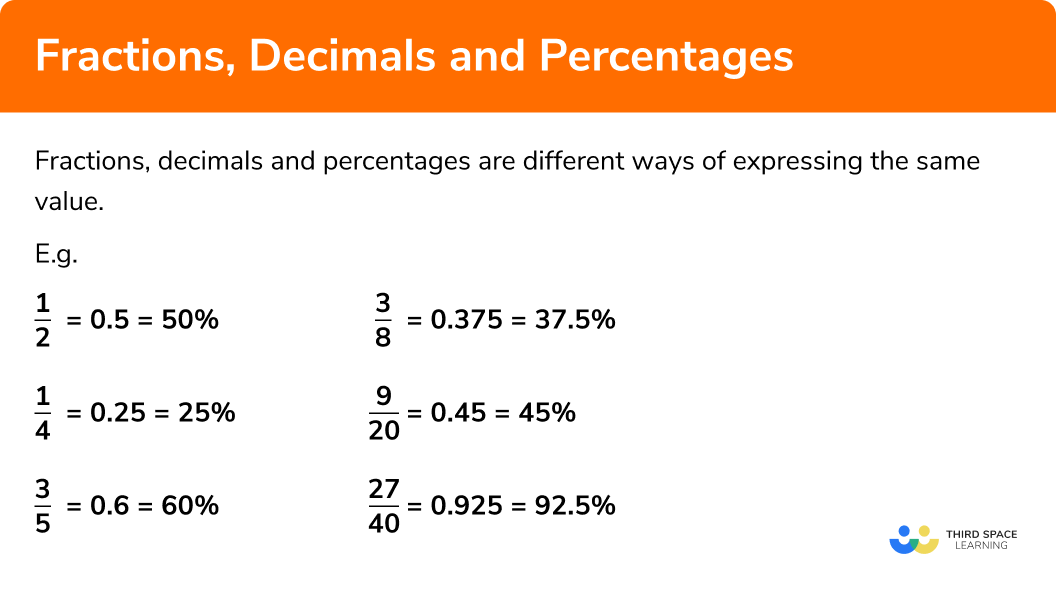One to one maths interventions built for KS4 success
Weekly online one to one GCSE maths revision lessons now available
This topic is relevant for:

Fractions, Decimals And Percentages
Here we will learn about fractions, decimals and percentages, including what they are, how to calculate with them and to solve problems involving them.
There are also fractions, decimals and percentages worksheets based on Edexcel, AQA and OCR exam questions, along with further guidance on where to go next if you’re still stuck.
What are fractions, decimals and percentages?
Fractions, decimals and percentages are different ways of representing a proportion of the same amount.
There is equivalence between fractions, decimals and percentages.
E.g.
What are fractions, decimals and percentages?

What are fractions?
Fractions are a way of writing equal parts of one whole.
They have a numerator (top number) and a denominator (bottom number).
The denominator shows how many equal parts the whole has been divided into.
The numerator shows how many of the equal parts we have.
E.g.
This shape has equal parts and of them are shaded.
This represents four ninths:
What are decimals?
Decimals are a way of writing numbers that are not whole.
Decimal numbers can be recognised as they have a decimal point.
A decimal place is a position after the decimal point.
E.g.
has two decimal places.
There is a in the tenths place and in the hundredths place.
E.g.
This shows the fraction
can also be written as
What are percentages?
Percentages are numbers which are expressed as parts of .
Percent means “number of parts per hundred” and the symbol we use for this is the percent sign (%).
E.g.
There are equal parts and of them are shaded.
How to use fractions, decimals and percentages
There are various ways of using fractions, decimals and percentages.
For examples, practice questions and worksheets on each one follow the links to the step by step guides below:
Comparing fractions, decimals and percentages
In order to compare fractions, decimals and percentages you need to be able to convert between them, including:
- Converting fractions to decimals
- Converting decimals to fractions
- Converting fractions to percentages
- Converting percentages to fractions
- Converting decimals to percentages
- Converting percentages to decimals
- Converting recurring decimals to fractions
Step-by-step guide: Converting fractions, decimals and percentages

Fractions, decimals and percentages worksheet

Get your free fractions, decimals and percentages worksheet of 20+ questions and answers. Includes reasoning and applied questions.
DOWNLOAD FREE
Fractions, decimals and percentages worksheet

Get your free fractions, decimals and percentages worksheet of 20+ questions and answers. Includes reasoning and applied questions.
DOWNLOAD FREEFractions, decimals and percentages examples
Fractions
1. Adding fractions
To add fractions they need to have a common denominator.
E.g.
- Step-by-step guide: Adding fractions
2. Subtracting fractions
To subtract fractions they need to have a common denominator.
E.g.
- Step-by-step guide: Subtracting fractions
3. Multiplying fractions
To multiply fractions we need to multiply the numerators together and multiply the denominators together.
E.g.
- Step-by-step guide: Multiplying fractions
4. Dividing fractions
To divide fractions we need to find the reciprocal of (flip) the second fraction, change the divide sign to a multiply and then multiply the fractions together.
E.g.
- Step-by-step guide: Dividing fractions
5. Equivalent fractions
Equivalent fractions are fractions that have the same value.
E.g.
- Step-by-step guide: Equivalent fractions
6. Improper fractions and mixed numbers
An improper fraction is a fraction where the numerator (top number) is larger than the denominator (bottom number).
A mixed number has a whole number part and a fractional part.
We can convert between improper fractions and mixed numbers:
E.g.
- Step-by-step guide: Improper fractions and mixed numbers
7. Ordering fractions
To order fractions they need to have a common denominator.
E.g.
Write these fractions in order of size from smallest to largest:
- Step-by-step guide: Ordering fractions
8. Fractions of an amount
We can calculate a fraction of a given amount.
E.g.
Calculate of :
- Step-by-step guide: Fractions amounts
Decimals
1. Adding decimals
We can add decimals together:
E.g.
Use the column method.
- Step-by-step guide: Adding decimals
2. Subtracting decimals
We can subtract decimals from each other:
E.g.
Use the column method.
- Step-by-step guide: Subtracting decimals
3. Multiplying decimals
We can multiply decimals:
E.g.
becomes
becomes
- Step-by-step guide: Multiplying decimals
4. Dividing decimals
We can divide decimals by using equivalent fractions to ensure that the divisor (the denominator) is an integer:
E.g.
- Step-by-step guide: Dividing decimals
Percentages
1. Percentage of an amount
We can find a percentage of an amount by breaking the percentage down:
E.g.
Find of
So,
- Step-by-step guide: Percentage of an amount
2. Percentage multipliers
We can use percentage multipliers to find a percentage of an amount or to increase/decrease by a percentage:
E.g.
Find of
The multiplier for is
- Step-by-step guide: Percentage multipliers
3. Percentage increase
We can increase a value by a percentage:
E.g.
Increase by
Either find of and add it on to , or use a multiplier.
- Step-by-step guide: Percentage increase
4. Percentage decrease
We can decrease a value by a percentage:
E.g.
Decrease by .
Either find of and subtract it from , or use a multiplier.
- Step-by-step guide: Percentage decrease
5. Percentage change
We can calculate the percentage change between two values:
E.g.
Calculate the percentage change from to .
Therefore the percentage change is .
- Step-by-step guide: Percentage change
6. Reverse percentages
We can use reverse percentages to calculate the original number:
E.g.
of a number is . What was the original number?
- Step-by-step guide: Reverse percentages
Comparing fractions, decimals and percentages
1. Fractions to decimals
Converting fractions to decimals:
Write as a decimal.
Divide the numerator by the decimal by using a written method or a calculator.
- Step-by-step guide: Fractions to decimals
2. Decimals to fractions
Converting decimals to fractions:
Write as a fraction.
Then cancel so that the fraction is in its simplest form.
- Step-by-step guide: Decimals to fractions
3. Fractions to percentages
Converting fractions to percentages:
Write as a percentage.
- Step-by-step guide: Fractions to percentages
4. Percentages to fractions
Converting percentages to fractions:
Write as a fraction.
- Step-by-step guide: Percentages to fractions
5. Decimal to percentage
Converting decimals to percentages:
Write as a percentage.
- Step-by-step guide: Decimal to percentage
6. Percentage to decimal
Converting percentages to decimals:
Write as a decimal.
- Step-by-step guide: Percentage to decimal
7. Recurring decimals to fractions
Converting recurring decimals to fractions:
- Step-by-step guide: Recurring decimals to fractions
Common misconceptions
- Common denominators
To be able to add, subtract or compare fractions they must have a common denominator. To do this you need to find a common multiple for the denominators. The lowest common denominator is the easiest to use.
- Fractions in their simplest form
Often fraction questions ask for the answer to be in its simplest form. This means you need to consider the numerator (the top number) and the denominator (the bottom number) and cancel by looking for common factors.
- Percentages can be greater than
Percentages can be more than . This can happen for a percentage increase and for calculating percentage change.
- The equivalence of one-third
Take care with one-third and its decimal and percentage equivalence.
Practice fractions, decimals and percentage questions
Fractions, decimals and percentages GCSE questions
1. (a) Write as a decimal
(b) Write as a fraction
(c) Write as a percentage
(3 marks)
(a)
(1)
(b)
(1)
(c)
(1)
2. Gordon buys a car.
The cost of the car is plus VAT at
Gordon pays a deposit of
He pays the rest in equal payments.
Work out the amount of each of the payments.
(4 marks)
(for finding of the price)
(1)
(for finding of the price)
(1)
(for finding calculating the remainder to be paid)
(1)
(for finding calculating the remainder to be paid)
(1)
3. Prove algebraically that the recurring decimal has the value of
(3 marks)
(for the correct recurring decimal)
(1)
(for the second recurring decimal and the subtraction)
(1)
(for the correct fraction)
(1)
Learning checklist
You have now learned how to:
- Order decimals and fractions
- Understand and use place value for decimals
- Use the operations, including formal written methods, applied to decimals, proper and improper fractions, and mixed numbers
- Define percentage as ‘number of parts per hundred’, interpret percentages and percentage changes as a fraction or a decimal, interpret these multiplicatively, express quantity as a percentage of another, compare quantities using percentages, and work with percentages greater than
- Convert fractions, decimals and percentages
The next lessons are
Still stuck?
Prepare your KS4 students for maths GCSEs success with Third Space Learning. Weekly online one to one GCSE maths revision lessons delivered by expert maths tutors.

Find out more about our GCSE maths tuition programme.

